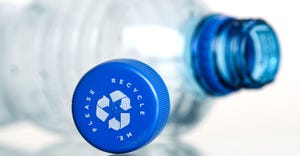Paying for Material Recovery: What’s in Your Wallet?
Despite legislative, regulatory, corporate or grassroots changes, the same question looms as large today as it has for the past 30 years.
Let’s admit it, with or without the admonitions of the Chinese government, it was time to face that our recycling systems had become unsustainable. We need a rethink at many levels. Progressives recognize this as an opportunity to embrace a circular economy mindset. We won’t get there unless we reset our goals, objectives and the metrics for successes.
Regardless of what legislative, regulatory, corporate or grassroots changes are initiated, the same question looms as large today as it has for the past 30 years: How and when in the system should we recoup the funds to pay for the cost of recovery?
Notice that who pays is not part of the question. It’s no secret that the consumer factors into every equation. The cost may be built into the product price, imposed as a fee or tax at the point of purchase or assessed at the end of life as a collection and processing fee. It may be collected as a dedicated tax or incorporated into the local tax general fund. Polluter taxes on products and hidden taxes on disposal are other examples.
Once we accept that in every funding scenario the consumer writes the check, it’s easier to deal more rationally with other complexities and nuances that influence participation and performance. The effectiveness of various funding schemes differs based on specific products and materials and the collection method. Likewise, why and how humans participate in those collection systems has affected the funding mechanism. There is a lot to consider.
Attitudes and behaviors can swing dramatically depending on when the consumer is asked to part with his or her hard-earned cash. Another influencing factor is whether the customer is aware of the charge. Miscalculating human behavior in program development can adversely affect all levels of stakeholders. Mistakes are common, and they can be costly.
Legislative and regulatory initiatives calling for disposal bans, diversion and recovery of added types and volumes of materials habitually come without economic analysis, financial support or the statutory authority to assess newly dedicated fees or taxes. Hardest hit are local governments that are traditionally responsible for assuring the availability of affordable waste management services for their constituents. Corporate money flows into trade and nonprofit organizations to be redistributed as grants and loans for equipment and infrastructure. It has been a boost to the cities that can afford their share of that arrangement. For those who struggle with operational cost, the story is quite different.
We’re not absolving local government for all their woes. Municipal officials are keenly aware that even open-minded constituents have financial thresholds. Once crossed, they are drawn to public outcry and undesirable practices. Consequently, local governments may absorb some or all the costs by shortchanging other legitimate budgetary demands.
Public health and safety issues become more complex when regulatory mandates include products and materials not readily incorporated into the local curbside collection program. Many of these mandates are part of extended producer responsibility (EPR) policies. The ugly truth about poorly designed EPR laws, particularly those accompanied by disposal bans, is that the increased costs for labor and drop-off collection facilities frequently fall to local government.
Compensation for the operational costs of local government collection programs has and continues to be a hotly debated sore spot. Producer takeback programs, legislated or voluntary, pay private transporters, recyclers and processors. Yet, manufacturers remain adamant that they bear no responsibility to local governments for the cost of collecting their products. Interestingly, when other nonprofit groups or private businesses perform the same point of collection functions, the financial arrangements are more favorable.
Producers are not the only ones forgetting that new collection programs create increasing expenses. Legislators and regulators may not understand the challenge of integrating these services.
Collection Methods, Funding Schemes and Consumer Behavior
Collectively, U.S. cities are trending toward $2 billion in annual recovery costs for bottles, cans, plastics, paper and paperboard. Add to that millions more to manage electronic waste, household hazardous waste, paint, tires, etc. There is no argument that consumers should pay to dispose of the waste they produce. What program managers need to consider is whether they have the right funding mechanism to deliver desirable program results.
For curbside collection, a direct fee for service funding is commonly accepted as the public norm. Typically, a pre-determined fee is billed quarterly in advance of service. Alternatively, several states allow local jurisdictions to assess dedicated property or per capita taxes to finance solid waste programs. Both systems work by spreading the cost of collection/disposal/recycling over the entire community in incremental payments. Residents pay for the convenience of having regularly scheduled service available regardless of their usage, much like fire and police protection. If structured properly, the fees or taxes enable communities to operate financially sustainable programs. Since the fee is billed directly to the user for a known service, residents have a greater vested interest in the quality and cost of the program. Participation runs higher as they are more receptive to reasonable rate increases to gain new services and conveniences.
Pay-as-you-throw (PAYT) programs differ from advance fee programs. Without a bill or tax for collection, customers pay only when they have items to discard. For curbside, residents typically purchase bags or tags sanctioned by the program. For drop-off programs, the fee is assessed at the point of collection. Because PAYT requires customers to make a conscious decision, it has a significantly different impact on performance and participation. The ability to avoid the cost of collection by making other inappropriate choices becomes not only tempting but commonplace. Consequently, participation is lower, recycling contamination rates are higher and theft of service is widespread. These can be minimized by implementing a universal collection fee that pays for collection while leaving disposal a variable cost.
Pay Me Now or Pay Me Later: Consumer Reaction to EPR
Public approval for EPR recovery programs runs high when there are no added charges at the time of return. Savvy consumers wisely suspect the cost of recovery is incorporated into the retail price. There is rarely any significant deviation in the manufacturer’s suggested retail price of items purchased in states with or without producer responsibility programs. There are many takes on this seemingly simple solution. The wrong combination of variables can quickly turn consumer satisfaction into anarchy. Convenience, access, limitations, conditions, etc., all play a role.
EPR programs may have visible fees to offset the costs. In these instances, timing is everything. Consumers are less likely to balk at paying fees when they purchase an item than when they want to rid themselves of it. Much like warranty programs, point-of-sale fees can provide consumers with a sense of security, knowing they have access to a convenient and well-thought-out recovery program. Understanding their own needs, buyers easily opt for the advance charge over a PAYT system.
Tiered or percentage-based taxes, which are calculated relevant to the purchase price of an item, are considered more fair than flat fees that remain the same regardless of the sale price. How this money is managed and by whom is a vital piece of program design. It can determine the sustainability of the program, the reliability and level of services provided and whether a fair and competitive field of service providers will manage the material.
California’s longstanding advance recovery tax system for e-waste is a success based on user approval ratings. It covers the costs of administration, collection, recycling and processing. Consumers may adapt readily to point-of-sale fees for consumer electronics; however, there are mixed feelings between retailers and original equipment manufacturers (OEMs), who are members of the Consumer Technology Association (CTA).
CTA recently fought a 0.5 percent point-of-sale fee in Pennsylvania claiming it would burden retailers, deter sales and decrease profits. The fee would be collected within the existing sales tax system that includes internet sales. The proceeds would support local government infrastructure and operational expenditures. Raising the fee to 1 percent would cover the OEM’s costs, too. (Full disclosure: We actively helped to develop and advocate for the Pennsylvania legislation.)
Despite vigorously objecting in Pennsylvania, CTA recently proposed a concept for federal legislation with a similar retail fee. Thumbs up to the concept of uniform recovery in all 50 states. Of course, we support a retail fee, but this proposal’s one-sidedness makes it hard to swallow as EPR. This advance recovery fee would cover OEM costs for recycling CRTs. The recovery program would be short lived and target CRT’s newly entering the waste stream. This falls short of resolving the broader spectrum of electronic scrap, which continues to grow by type and volume. In addition, the proposed fee would fund the cleanup liabilities for warehouses of CRTs improperly managed by certified recyclers in OEM collection plans. Due to market conditions, we can turn a blind eye to subsidizing what could be crippling costs to well-intentioned CTA members. Most disappointing, and conspicuously missing, is payment for the collection costs of local governments, which play a large role in every state with CTA member-related programs. Worse yet, the proposal would preclude states from enacting legislation, with point-of-sale fees to address that shortcoming.

Cheers and Jeers for Checkoff Programs
Casual references to checkoff plans have been creeping into industry discussions. The industry is always on the lookout for out-of-the-box funding solutions and this qualifies. While not new, checkoff programs would be novel for the recycling industry. Simply put, checkoff programs are the result of the Commodity Promotion, Research, and Information Act of 1996. Lots of commodities (primarily agricultural) have checkoff programs. Producers of all types and sizes support these efforts by paying a mandatory production-based stipend to a quasi-government board. According to law, programs are supposed to collectively benefit all participants. Over the years, the checkoff boards delivered some of the most memorable lines in advertising: “Got Milk?” “Beef. It’s what’s for dinner.”
The idea is not without dangers and pitfalls.
Checkoff programs are under increasing scrutiny from allegations of mismanagement. At question is the distribution and use of money that was to be government controlled. Over time, many funds were funneled directly to select corporate lobbying groups who set the priorities and spending plans. In other words, Big Ag benefitted at the expense of the small producers. For these reasons, the courts ended the relationship between the National Pork Board and the National Pork Producers Council (NPPC).
As an industry, we need to investigate and consider the potential for corruption before we move to a checkoff program. NPPC is not an isolated case. Other industry-led lobbying and trade groups also had their hands in the checkoff money till.
The recycling industry is very diverse commodity wise and has many levels of participants. How would the stipend be assessed in the supply chain? Would each commodity have a separate fee and managing board, or would it be used for a common need? As far as who would pay the stipend, there is no question. It still trickles down to the consumer, who may reap little benefit.
Michele Nestor is the president of Nestor Resources Inc., based in the Greater Pittsburgh area, and chair of the board of directors of the Pennsylvania Recycling Markets Center, Penn State, Harrisburg. She helps private and public sector organizations develop strategic plans to survive in a transitioning marketplace.
About the Author(s)
You May Also Like


